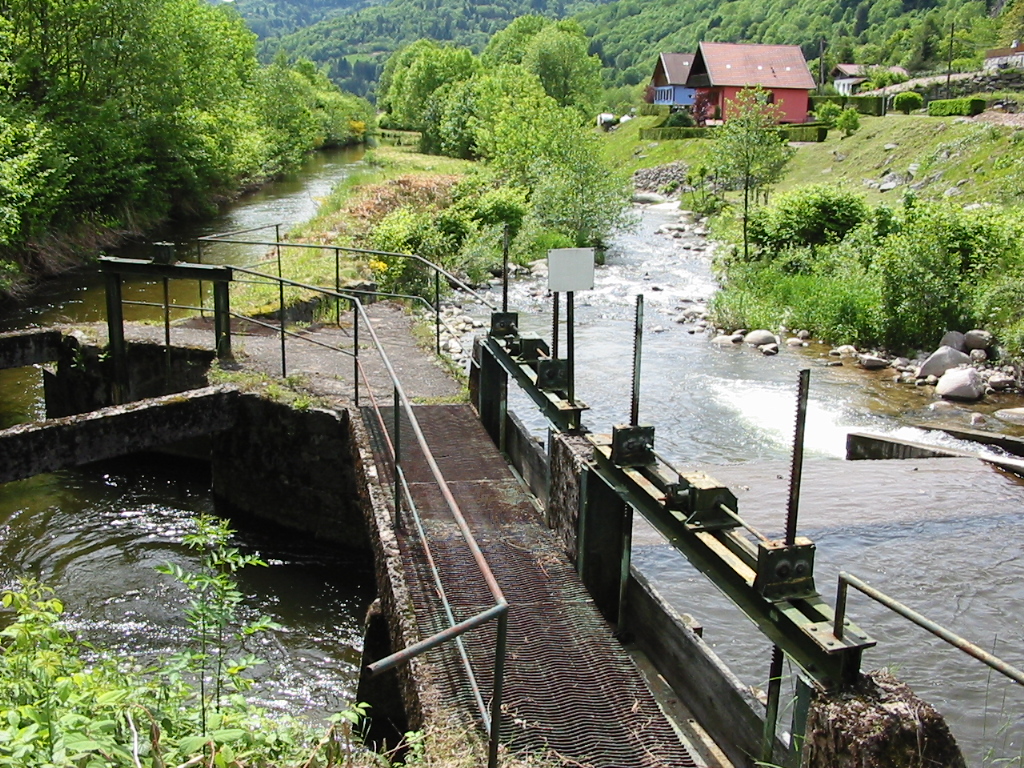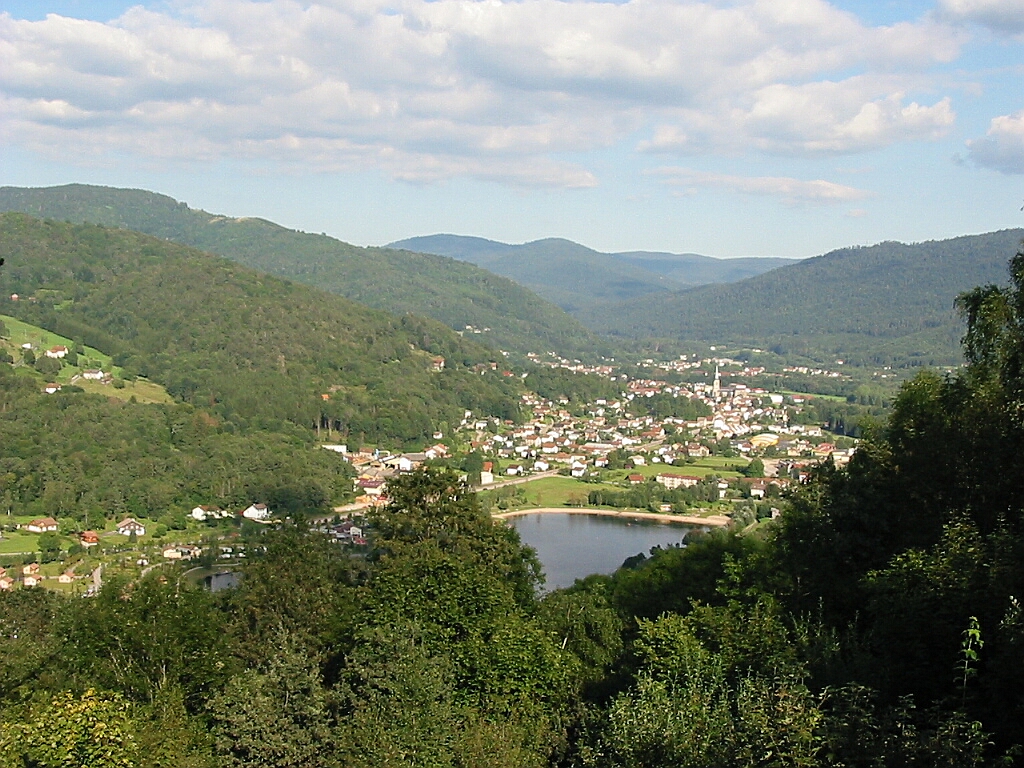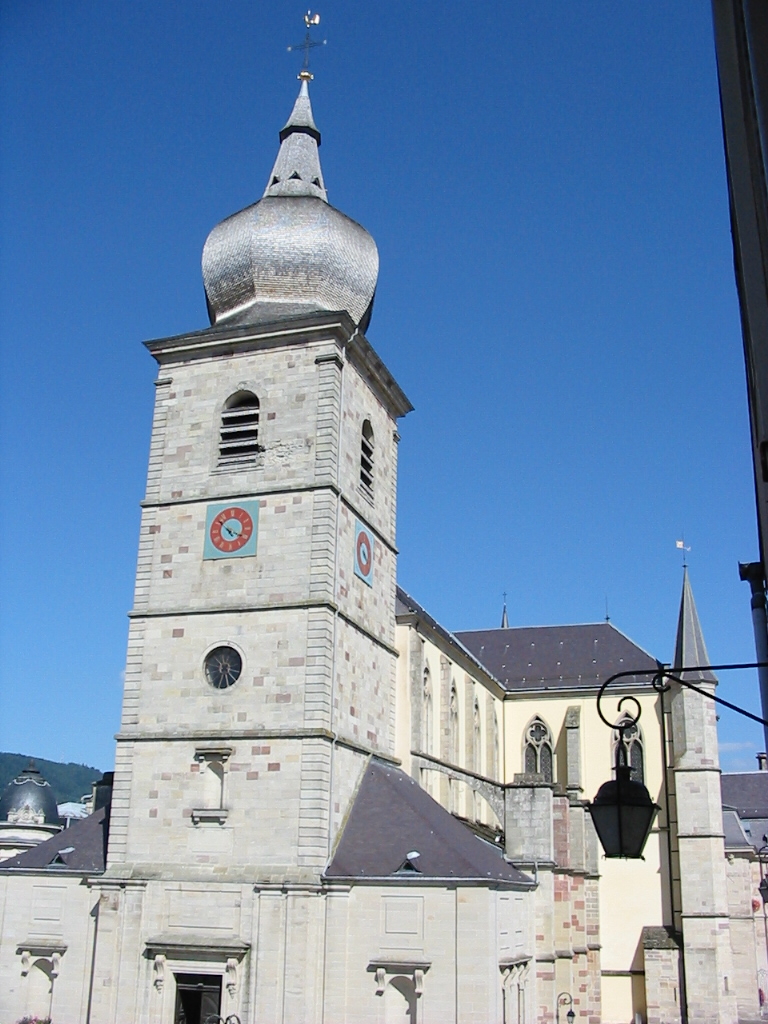Moselotte on:
[Wikipedia]
[Google]
[Amazon]
 The Moselotte () is a
The Moselotte () is a
SIERM – Système d'Information sur l'Eau Rhin-Meuse: Qualité de l'eau superficielle (cours d'eau)
/ref> The reason was a highly depressed rate of oxygen saturation (also classed as "passable"), which had gone from 76% in 2005 to 69% in 2006. The


Description on the Pays de Remiremont website
* {{Authority control Rivers of Vosges (department) Rivers of Grand Est Rivers of France
 The Moselotte () is a
The Moselotte () is a river
A river is a natural flowing watercourse, usually freshwater, flowing towards an ocean, sea, lake or another river. In some cases, a river flows into the ground and becomes dry at the end of its course without reaching another body of wate ...
in Lorraine
Lorraine , also , , ; Lorrain: ''Louréne''; Lorraine Franconian: ''Lottringe''; german: Lothringen ; lb, Loutrengen; nl, Lotharingen is a cultural and historical region in Northeastern France, now located in the administrative region of Gr ...
, in the French
French (french: français(e), link=no) may refer to:
* Something of, from, or related to France
** French language, which originated in France, and its various dialects and accents
** French people, a nation and ethnic group identified with Franc ...
department of Vosges. It is a direct right tributary
A tributary, or affluent, is a stream or river that flows into a larger stream or main stem (or parent) river or a lake. A tributary does not flow directly into a sea or ocean. Tributaries and the main stem river drain the surrounding drainage ...
of the Moselle
The Moselle ( , ; german: Mosel ; lb, Musel ) is a river that rises in the Vosges mountains and flows through north-eastern France and Luxembourg to western Germany. It is a bank (geography), left bank tributary of the Rhine, which it jo ...
, and thus a sub-tributary of the Rhine
), Surselva, Graubünden, Switzerland
, source1_coordinates=
, source1_elevation =
, source2 = Rein Posteriur/Hinterrhein
, source2_location = Paradies Glacier, Graubünden, Switzerland
, source2_coordinates=
, so ...
.
Geography
The Moselotte rises in the massif des Vosges at the fontaine de la Duchesse, near the summit of Hohneck. It flows into the Moselle atRemiremont
Remiremont (; german: Romberg or ) is a town and commune in the Vosges department, northeastern France, situated in southern Grand Est. The town has been an abbatial centre since the 7th century, is an economic crossroads of the Moselle and Mosel ...
. Its length is , while its watershed
Watershed is a hydrological term, which has been adopted in other fields in a more or less figurative sense. It may refer to:
Hydrology
* Drainage divide, the line that separates neighbouring drainage basins
* Drainage basin, called a "watershe ...
is .
Communes traversed by the Moselotte
The Moselotte flows through, from upstream to downstream, the communes ofLa Bresse
La Bresse () is a commune in the Vosges department in Grand Est in northeastern France. The area is known for its ski resorts and outdoor activities.
La Bresse is located about 45 km west of Colmar and 55 km north west of Mulhouse in ...
, Cornimont
Cornimont (; german: Hornenberg) is a commune in the Vosges department in Grand Est in northeastern France.
History
A World War II tank battle was fought in Cornimont at Haut-du-Faing on 16 October 1944.
See also
*Communes of the Vosges departm ...
, Saulxures, Thiéfosse
Thiéfosse () is a commune in the Vosges department in Grand Est in northeastern France.
See also
*Communes of the Vosges department
The following is a list of the 507 communes of the Vosges department of France.
The communes cooperate in th ...
, Vagney
Vagney () is a commune in the Vosges department in Grand Est in northeastern France.
See also
*Communes of the Vosges department
The following is a list of the 507 communes of the Vosges department of France.
The communes cooperate in the f ...
, Saint-Amé, Le Syndicat, Dommartin-lès-Remiremont
Dommartin-lès-Remiremont (, literally ''Dommartin near Remiremont'') is a commune in the Vosges department in Grand Est in northeastern France. The archivist-palaeographer Michel François (1906–1981) was born in Dommartin.
See also
*Commune ...
and Saint-Étienne-lès-Remiremont
Saint-Étienne-lès-Remiremont (, literally ''Saint-Étienne near Remiremont'') is a commune in the Vosges department in Grand Est in northeastern France.
See also
*Communes of the Vosges department
The following is a list of the 507 communes ...
opposite the town of Remiremont.
Main tributaries
The Moselotte is fed by the following tributaries:Lakes
The Moselotte watershed includes numerous natural lakes which are often enhanced by a small barrage, includinglac de Blanchemer
Lac de Blanchemer is a lake at La Bresse in Vosges, France.
Electricity production
In 1959, a hydroelectric power plant
Hydroelectricity, or hydroelectric power, is electricity generated from hydropower (water power). Hydropower supplies ...
, lac de Lispach and lac des Corbeaux.
The presence of a high barrage at the foot of Kastelberg
The Kastelberg is the fourth highest summit of the Vosges Mountains. It is located on the former border between the French regions of Alsace and Lorraine.
Etymology
In German ''Kastelberg'' means ''mountain of the castle''.
Geography
The m ...
since 1983 has resulted in the appearance of the lac de la Lande
Lac de la Lande is a lake in Vosges, France
France (), officially the French Republic ( ), is a country primarily located in Western Europe. It also comprises of overseas regions and territories in the Americas and the Atlantic, Pac ...
. It collects water from several sources via conduits, and supplies the La Bresse commune with its energy.
At the entry downstream of Saulxures, a lake of was set up in 1998 under the name lac de la Moselotte
Lac is the resinous secretion of a number of species of lac insects, of which the most commonly cultivated is ''Kerria lacca''.
Cultivation begins when a farmer gets a stick that contains eggs ready to hatch and ties it to the tree to be infes ...
which hosts a leisure center
A leisure centre in the United Kingdom, Ireland, Australia (also called aquatic centres), Singapore and Canada is a purpose-built building or site, usually owned and operated by the city, borough council or municipal district council, where people ...
.
Hydrology – at Vagney station
Like the majority of Vosges rivers, the Moselotte is very substantial. Its flow rate has been observed during a period of 40 yearsVagney
Vagney () is a commune in the Vosges department in Grand Est in northeastern France.
See also
*Communes of the Vosges department
The following is a list of the 507 communes of the Vosges department of France.
The communes cooperate in the f ...
at a place called Zainvilliers, which is upstream of the Moselotte's confluence with the Moselle. The river's watershed at this point is or 53 percent of its entire watershed, corresponding to the upper half of its course.
The average interannual flow rate, or discharge
Discharge may refer to
Expel or let go
* Discharge, the act of firing a gun
* Discharge, or termination of employment, the end of an employee's duration with an employer
* Military discharge, the release of a member of the armed forces from serv ...
at Vagney is .
The Moselotte exhibits quite marked seasonal fluctuations, with a winter-spring period of high water whose monthly average flow rate is between from November to April inclusive, with a maximum in December. From the beginning of May, the flow rate falls off rapidly, reaching in August, which is not very severe for a body of water of this size. However year by year fluctuation can be more significant, as can those in the short term.
At low water, the 3-year low instantaneous flow rate can drop to in the case of a dry five-year period, or about , which is quite severe, but typical of rivers in the Moselle basin.
Floods can also be significant particularly bearing in mind the smallness of the watershed, only . The maximum instantaneous flow rates over a 2-year and 5-year period (MIFR2 and MIFR5) measure respectively. The MIFR10 is , the MIFR20 is , while the MIFR50 rises to .
The maximum instantaneous flow rate recorded at Vagney was on 15 February 1990, while the maximum daily average flow rate was on the same day. Comparing these values to the MIFR measurements for the river suggests that the flood on that day was approximately a 10-year event and thus likely to recur frequently.
Overall the Moselotte is an extremely abundant river in its upper course. The runoff curve number The runoff curve number (also called a curve number or simply CN) is an empirical parameter used in hydrology for predicting direct runoff or infiltration from rainfall excess. The curve number method was developed by the USDA Natural Resources Con ...
in this 53 percent of its watershed is annually, which is extremely high for the northern part of France, and more than four times higher than the French national average. It is also three times higher than the average over the French basin of the Moselle. The specific flow rate attaches to these facts the portentous figure of 45.7 litres per second per square kilometre of watershed.
Hydrology – at the confluence with the Moselle
The interannual flow rate/discharge of the Moselotte at its confluence with the Moselle is , for a watershed of . The runoff curve number in its watershed is , which is very high indeed, not merely much higher than the average for France (by more than a factor of three) with all basins included, but also much higher than the average for the French Moselle basin. In fact, the runoff curve number atHauconcourt
Hauconcourt (; ) is a commune in the Moselle department in Grand Est in north-eastern France.
See also
* Communes of the Moselle department
The following is a list of the 725 communes of the Moselle department of France.
The communes coop ...
, located slightly downstream of the town of Metz
Metz ( , , lat, Divodurum Mediomatricorum, then ) is a city in northeast France located at the confluence of the Moselle and the Seille rivers. Metz is the prefecture of the Moselle department and the seat of the parliament of the Grand E ...
, near where it leaves French territory, rises to . The specific flow rate of the Moselotte rises to 38.5 litres per second per square kilometre of watershed. This, along with the Breuchin (a tributary of the Lanterne and sub-tributary of the Saône
The Saône ( , ; frp, Sona; lat, Arar) is a river in eastern France. It is a right tributary of the Rhône, rising at Vioménil in the Vosges department and joining the Rhône in Lyon, at the southern end of the Presqu'île.
The name deri ...
which flows elsewhere in the same region) constitutes a record for the north third of France.
The Moselotte is clearly more abundant than the Moselle at their confluence, against .
Water quality
While in 2005, the water quality of the Moselotte was classified as category 1B, or "bonne" (good), the situation deteriorated somewhat in 2006, when the Rhine-Meuse water agency concluded that the river water analysed at the level of Autrive was now only "passable", or category 2./ref> The reason was a highly depressed rate of oxygen saturation (also classed as "passable"), which had gone from 76% in 2005 to 69% in 2006. The
chemical oxygen demand
In environmental chemistry, the chemical oxygen demand (COD) is an indicative measure of the amount of oxygen that can be consumed by reactions in a measured solution. It is commonly expressed in mass of oxygen consumed over volume of solution whic ...
, at 6.5 mg/L in 2006, was still classified "bonne". The ammonium ion
The ammonium cation is a positively-charged polyatomic ion with the chemical formula or . It is formed by the protonation of ammonia (). Ammonium is also a general name for positively charged or protonated substituted amines and quaternary a ...
level was measured at 0.09 mg/L, which was classed as "excellent".



Economy
Highly populated bytrout
Trout are species of freshwater fish belonging to the genera '' Oncorhynchus'', ''Salmo'' and ''Salvelinus'', all of the subfamily Salmoninae of the family Salmonidae. The word ''trout'' is also used as part of the name of some non-salmoni ...
, the river has given rise to a significant breakthrough in fish farming
upright=1.3, Salmon farming in the sea (mariculture) at Loch Ainort, Isle of Skye">mariculture.html" ;"title="Salmon farming in the sea (mariculture">Salmon farming in the sea (mariculture) at Loch Ainort, Isle of Skye, Scotland
Fish farming or ...
, namely the invention of artificial reproduction by Joseph Remy and Antoine Géhin in the 19th century. The Moselotte basin also has the highest density in the world in small hydroelectric barrages, which serve the watermill
A watermill or water mill is a mill that uses hydropower. It is a structure that uses a water wheel or water turbine to drive a mechanical process such as milling (grinding), rolling, or hammering. Such processes are needed in the production of ...
s, sawmill
A sawmill (saw mill, saw-mill) or lumber mill is a facility where logs are cut into lumber. Modern sawmills use a motorized saw to cut logs lengthwise to make long pieces, and crosswise to length depending on standard or custom sizes (dimensi ...
s, spinning
Spin or spinning most often refers to:
* Spinning (textiles), the creation of yarn or thread by twisting fibers together, traditionally by hand spinning
* Spin, the rotation of an object around a central axis
* Spin (propaganda), an intentionally b ...
and weaving
Weaving is a method of textile production in which two distinct sets of yarns or threads are interlaced at right angles to form a fabric or cloth. Other methods are knitting, crocheting, felting, and braiding or plaiting. The longitudinal th ...
houses along the river and its tributaries.
: ''The photograph opposite, taken upstream of La Bresse, shows a diversion powering a turbine. The main point has been equipped with a fish ladder
A fish ladder, also known as a fishway, fish pass, fish steps, or fish cannon is a structure on or around artificial and natural barriers (such as dams, locks and waterfalls) to facilitate diadromous fishes' natural migration as well as movemen ...
.''
A railway line
Rail terminology is a form of technical terminology. The difference between the American term ''railroad'' and the international term ''railway'' (used by the International Union of Railways and English-speaking countries outside the United Sta ...
once ran along the Moselotte valley between Remiremont and Cornimont. Today it has been transformed into a ''voie verte'' (green route) and replaced with bus service provided by TER Grand Est
TER Grand Est or TER Fluo is the regional rail network serving the region of Grand Est, northeastern France. It is operated by the French national railway company SNCF. It was formed in 2016 from the previous TER networks TER Alsace, TER Lorra ...
(line L09), extended to La Bresse.
See also
*List of rivers of France
This is a list of rivers that are at least partially in France. The rivers are grouped by sea or ocean. The rivers flowing into the sea are sorted along the coast. Rivers flowing into other rivers are listed by the rivers they flow into. Some rive ...
References
External links
*Description on the Pays de Remiremont website
* {{Authority control Rivers of Vosges (department) Rivers of Grand Est Rivers of France